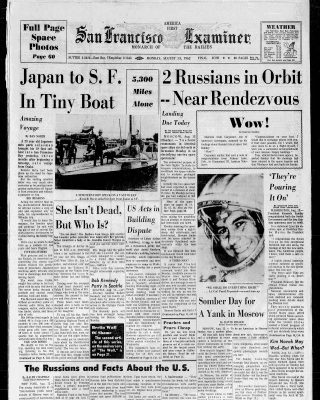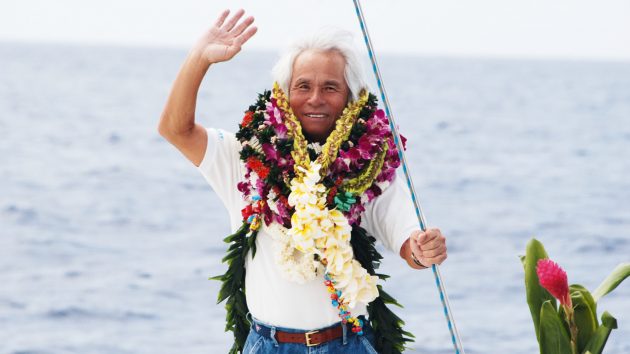His age-defying achievements are the stuff of legend, says Nic Compton, but how did the gentle, unassuming Kenichi Horie fulfil such huge sailing ambitions?
This sounds like one of those puzzles that do the rounds on social media: Kenichi Horie held the record for being both the youngest and the oldest person to sail across the Pacific single-handed and non-stop. How is that possible? And, no, the answer isn’t that he’s the only person to have done it. The correct answer is that he first sailed across the Pacific (solo and non-stop) in 1962 at the age of 23, becoming the first (and therefore the youngest) person to do so. He then did it again in 2022 at the age of 83, becoming the oldest person to do so. To hold both records is an extraordinary achievement – and probably a record in itself.
But that’s not all. In between those two landmark voyages, Kenichi Horie has sailed around the world three times (westabout, eastabout and vertically) and has crossed the Pacific a further seven times. Along the way, he has set a variety of other records, including the longest journey by pedalboat, the smallest boat to sail across the Pacific, and the fastest crossing of the Pacific by a solar-powered boat.
He has also become a household name in Japan and acquired a towering name among sailing folk the world over. His latest record earned him the prestigious Blue Medal Award from the Cruising Club of America – a special prize for a man who has spent much of his life sailing between Japan and the USA.

Horie celebrates as he arrives in San Francisco aboard Mermaid after crossing the Pacific in 1962, aged just 23
Ambitious beginnings
Born in Osaka, on the south coast of Japan, Kenichi Horie had no family history of sailing. The Horie family owned a car parts factory and young Kenichi’s first job was as a salesman for the family business. While he was at university, he joined the sailing club because ‘it sounded like fun’ and started reading about ocean adventurers such as Alain Bombard and Joshua Slocum. But it was the announcement of the first OSTAR that seemed to ignite his passion.

Making headlines in
1962 for his first singlehanded Pacific crossing
‘I was surprised and felt that the “conquering the world’s ocean by small boat” era had already begun,’ he says. ‘Both Sopranino [the 19-footer that Ellam and Mudie sailed across the Atlantic in 1953] and Trekka [the 20-footer that Guzzwell sailed around the world in the 1950s] are small sailing cruisers but they sailed across the Atlantic Ocean and around the world. Therefore, though crossing the Pacific is a bit longer than crossing the Atlantic, I felt it was very much a possibility.’
And so he bought the plans for a modest 19ft plywood sloop from designer Akira Yokoyama and had it built at a boatyard in Osaka. He named the boat Mermaid simply because that was the logo of the textiles company that had sponsored his sails. For the next 60 years he would include the name in all but one of the dozen or so boats he sailed in his various nautical adventures.
The strong, silent type
Meeting Kenichi Horie now, you might think he was too quiet and gentle for such a daring adventure, but even aged 23 he had a determined streak. When the Japanese refused to issue him with a passport or American currency for his first voyage because they considered it too dangerous, Horie went anyway.
He left Japan on 12 May 1962 and arrived in San Francisco 94 days later, sailing into the history books as the first person to sail singlehanded and non-stop across the Pacific. To the US immigration, he was just another illegal immigrant trying to enter the country with no passport or money, and he was duly arrested. It took the mayor to intervene and not only issue a 30-day visa, but make him an honorary citizen of San Francisco.
Such was his sensational reception in the US that when he eventually flew back to Japan, the authorities had to drop their threats of prosecution and Kenichi Horie was welcomed home as a national hero.
A best-selling book and a successful film of the voyage soon followed, cementing his place in the public consciousness. He’s managed to stay there ever since, through a series of daring and often improbable voyages and stunts, earning himself the title of Japan’s most famous ocean yachtsman.

Arriving in San Francisco in 2002, after another voyage across the Pacific from Osaka, Japan aboard Malt’s Mermaid III, a boat made from recycled whiskey barrels
Indomitable spirit
It started in 1972, with his first attempt to sail around the world ‘eastabout’ on the 24ft Mermaid II. The trip ended in disaster when the boat was damaged and Horie had to be rescued by the Japanese coastguard. Undaunted, he was back two years later sailing the ‘wrong’ way around the world (westabout) on the 29ft Mermaid III, becoming the first Japanese sailor to complete a non-stop solo circumnavigation, with a new record of 275 days.
To mix things up, his next voyage was a ‘vertical’ circumnavigation, which he completed in stages in 1978-82 on a 34ft aluminium yacht also called Mermaid. This time, his wife, Eriko, joined him for most of the journey, stopping at ten ports along the way, visiting North and South America as well as the Arctic and Antarctic. Even though the project nearly ended in disaster when the yacht capsized on one of the legs and stayed inverted for 20 minutes before righting itself, Kenichi Horie regards it as his favourite voyage.

Horie became the oldest sailor to cross the Pacific singlehanded and non-stop in 2022, earning him the prestigious Blue Water Medal from the Cruising Club of America
Apart from this one exception, Horie usually sails alone. ‘I think the hurdle is higher, that it’s more challenging, to sail solo than with multiple crews,’ he says. ‘My basic belief and the starting point of sailing is: to sail the world’s vast ocean on the world’s smallest sailboats.’ In his first book, Koduko: Sailing alone Across the Pacific, he gives a different reason for sailing solo: ‘The crew matters the most,’ he wrote, and the best crew he could find was himself!
Yet, despite his considerable experience, Kenichi Horie has rarely competed in any of the singlehanded races that proliferated from 1960 onwards, preferring to sail truly alone. The single exception was the 1975-6 Trans-Pacific Singlehanded Race, in which he finished third.
A true eco warrior
From 1985 onwards, many of Horie’s voyages have carried an environmental message, either testing alternative forms of energy (including crossing the Pacific twice on solar-powered boats) or through extensive use of recycled materials.
He took this to a new level in 1999, when he crossed the Pacific solo on a 33ft catamaran made of 528 beer kegs welded end-to-end (he joked that only 500 of the barrels were empty). The masts were made from recycled aluminium cans, and the sails of recycled plastic bottles – a theme he would return to repeatedly on future boats.

Aboard his record-breaking wave-powered boat Suntory Mermaid II
Three years later, he sailed the other way – from Japan to San Francisco – on a boat made from the wood of old whiskey barrels and fitted with hydrogen fuel cells. (It will come as no surprise that his sponsor by now was the Japanese brewing and distilling company, Suntory.)
‘People are using recycled materials to create a recycle-oriented society now,’ he says. ‘As a member of society, I also consider the environment as much as possible by using recycled materials. I would be happy if, by acting in an environmentally-conscious manner myself, it helps other people become interested in the environment.’
One of his most remarkable voyages was on Suntory Mermaid II, a 31ft catamaran driven by wave power, on which he crossed the Pacific from Hawaii to Japan in 2008. The boat was fitted with two fins at the bow which moved up and down with the waves and propelled the boat forward ‘like the tails of dolphins and whales’. It was an eye-opening concept which he hoped to prove was viable even on a long ocean voyage – albeit not travelling at great speed.
The boat averaged just 1.5 knots during the 3,780-mile crossing, which took Kenichi Horie more than three months to complete.‘Throughout history, mankind has used wind for power, but no one has been serious about wave power,’ he told AFP News.

After receiving the prestigious Blue Water Medal from the Cruising Club of America
The record-breaking continues
For his latest Pacific crossing, Horie went back to his roots with a 19ft cutter. Once again, simplicity was key, and Suntory Mermaid III wasn’t fitted with a watermaker or an engine and was powered by a single solar-powered battery. She did, however, have a windvane, GPS and a satellite phone. Horie also took a sextant with him, just as he did in 1962.
Horie sailed from westward this time – from San Francisco to Japan. When asked why, he replied: ‘Because it’s warmer. On the Japan to San Francisco route you have to go north of the Pacific High, which is cold, and I want to wear a T-shirt. I will sail about two miles south of Hawaii, so it will be warmer.’
Horie set off from San Francisco on 27 March 2022 and arrived in Japan 69 days later – an improvement on the 94 days it took him in 1962. What’s more, this time he had a passport and money with him and was welcomed with open arms.
His reaction when he reached the end of his voyage? ‘I want to do it again,’ he said. ‘When I am 100 years old.’ Watch this space. This octogenarian sailor isn’t ready to hang up his sailing boots any time soon.
Enjoyed reading this?
A subscription to Yachting Monthly magazine costs around 40% less than the cover price.
Print and digital editions are available through Magazines Direct – where you can also find the latest deals.
YM is packed with information to help you get the most from your time on the water.
-
-
- Take your seamanship to the next level with tips, advice and skills from our experts
- Impartial in-depth reviews of the latest yachts and equipment
- Cruising guides to help you reach those dream destinations
-
Follow us on Facebook, Twitter and Instagram.





